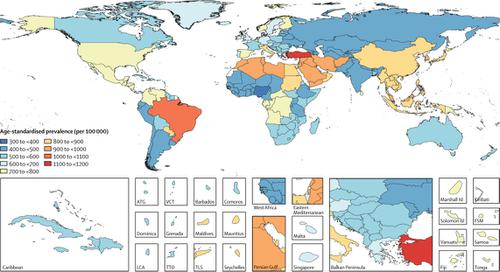Our official English website, www.x-mol.net, welcomes your feedback! (Note: you will need to create a separate account there.)
Global, regional, and national burden of Alzheimer's disease and other dementias, 1990-2016: a systematic analysis for the Global Burden of Disease Study 2016.
The Lancet ( IF 98.4 ) Pub Date : 2018-11-26 , DOI: 10.1016/s1474-4422(18)30403-4
The Lancet ( IF 98.4 ) Pub Date : 2018-11-26 , DOI: 10.1016/s1474-4422(18)30403-4

|
BACKGROUND
The number of individuals living with dementia is increasing, negatively affecting families, communities, and health-care systems around the world. A successful response to these challenges requires an accurate understanding of the dementia disease burden. We aimed to present the first detailed analysis of the global prevalence, mortality, and overall burden of dementia as captured by the Global Burden of Diseases, Injuries, and Risk Factors (GBD) Study 2016, and highlight the most important messages for clinicians and neurologists.
METHODS
GBD 2016 obtained data on dementia from vital registration systems, published scientific literature and surveys, and data from health-service encounters on deaths, excess mortality, prevalence, and incidence from 195 countries and territories from 1990 to 2016, through systematic review and additional data-seeking efforts. To correct for differences in cause of death coding across time and locations, we modelled mortality due to dementia using prevalence data and estimates of excess mortality derived from countries that were most likely to code deaths to dementia relative to prevalence. Data were analysed by standardised methods to estimate deaths, prevalence, years of life lost (YLLs), years of life lived with disability (YLDs), and disability-adjusted life-years (DALYs; computed as the sum of YLLs and YLDs), and the fractions of these metrics that were attributable to four risk factors that met GBD criteria for assessment (high body-mass index [BMI], high fasting plasma glucose, smoking, and a diet high in sugar-sweetened beverages).
FINDINGS
In 2016, the global number of individuals who lived with dementia was 43·8 million (95% uncertainty interval [UI] 37·8-51·0), increased from 20.2 million (17·4-23·5) in 1990. This increase of 117% (95% UI 114-121) contrasted with a minor increase in age-standardised prevalence of 1·7% (1·0-2·4), from 701 cases (95% UI 602-815) per 100 000 population in 1990 to 712 cases (614-828) per 100 000 population in 2016. More women than men had dementia in 2016 (27·0 million, 95% UI 23·3-31·4, vs 16.8 million, 14.4-19.6), and dementia was the fifth leading cause of death globally, accounting for 2·4 million (95% UI 2·1-2·8) deaths. Overall, 28·8 million (95% UI 24·5-34·0) DALYs were attributed to dementia; 6·4 million (95% UI 3·4-10·5) of these could be attributed to the modifiable GBD risk factors of high BMI, high fasting plasma glucose, smoking, and a high intake of sugar-sweetened beverages.
INTERPRETATION
The global number of people living with dementia more than doubled from 1990 to 2016, mainly due to increases in population ageing and growth. Although differences in coding for causes of death and the heterogeneity in case-ascertainment methods constitute major challenges to the estimation of the burden of dementia, future analyses should improve on the methods for the correction of these biases. Until breakthroughs are made in prevention or curative treatment, dementia will constitute an increasing challenge to health-care systems worldwide.
FUNDING
Bill & Melinda Gates Foundation.
中文翻译:

1990-2016 年阿尔茨海默病和其他痴呆症的全球、区域和国家负担:2016 年全球疾病负担研究的系统分析。
背景 患有痴呆症的人数正在增加,对世界各地的家庭、社区和医疗保健系统产生负面影响。成功应对这些挑战需要准确了解痴呆症疾病负担。我们的目标是首次对 2016 年全球疾病、伤害和风险因素 (GBD) 负担研究 (GBD) 捕获的痴呆症全球患病率、死亡率和总体负担进行详细分析,并强调对临床医生和神经科医生最重要的信息. 方法 GBD 2016 从 1990 年至 2016 年 195 个国家和地区的人口动态登记系统、已发表的科学文献和调查以及来自 195 个国家和地区的死亡、超额死亡率、患病率和发病率的卫生服务遭遇数据中获得了痴呆症数据,通过系统审查和额外的数据搜索工作。为了纠正不同时间和地点的死因编码差异,我们使用患病率数据和最有可能将死亡编码为痴呆症相对于患病率的国家的超额死亡率估计值,对痴呆症导致的死亡率进行建模。通过标准化方法分析数据,以估计死亡、患病率、生命损失年数 (YLL)、残疾生命年数 (YLD) 和残疾调整生命年数 (DALY;计算为 YLL 和 YLD 的总和),以及这些指标中可归因于满足 GBD 评估标准的四个风险因素(高体重指数 [BMI]、高空腹血糖、吸烟和高含糖饮料饮食)的分数。调查结果 2016 年,全球患有痴呆症的人数为 43·8 百万(95% 不确定区间 [UI] 37·8-51·0),比 1990 年的 2020 万(17·4-23·5)有所增加。这一增长117% (95% UI 114-121) 与年龄标准化患病率略有增加 1·7% (1·0-2·4) 相比,每 100 000 人有 701 例 (95% UI 602-815)从 1990 年到 2016 年每 10 万人中有 712 例 (614-828) 例。2016 年女性患痴呆症的人数多于男性(27·0 百万,95% UI 23·3-31·4,对比 1680 万,14.4-19.6) ,痴呆症是全球第五大死因,导致 2·4 百万 (95% UI 2·1-2·8) 人死亡。总体而言,28·8 百万 (95% UI 24·5-34·0) DALYs 归因于痴呆症;其中 6·4 百万 (95% UI 3·4-10·5) 可归因于高 BMI、高空腹血糖、吸烟、以及大量摄入含糖饮料。解读 从 1990 年到 2016 年,全球患有痴呆症的人数增加了一倍多,这主要是由于人口老龄化和增长的加剧。尽管死因编码的差异和病例确定方法的异质性对痴呆症负担的估计构成了重大挑战,但未来的分析应该改进纠正这些偏差的方法。在预防或治疗方面取得突破之前,痴呆症将对全世界的医疗保健系统构成越来越大的挑战。资助比尔和梅琳达·盖茨基金会。尽管死因编码的差异和病例确定方法的异质性对痴呆症负担的估计构成了重大挑战,但未来的分析应该改进纠正这些偏差的方法。在预防或治疗方面取得突破之前,痴呆症将对全世界的医疗保健系统构成越来越大的挑战。资助比尔和梅琳达·盖茨基金会。尽管死因编码的差异和病例确定方法的异质性对痴呆症负担的估计构成了重大挑战,但未来的分析应该改进纠正这些偏差的方法。在预防或治疗方面取得突破之前,痴呆症将对全世界的医疗保健系统构成越来越大的挑战。资助比尔和梅琳达·盖茨基金会。
更新日期:2018-11-27
中文翻译:

1990-2016 年阿尔茨海默病和其他痴呆症的全球、区域和国家负担:2016 年全球疾病负担研究的系统分析。
背景 患有痴呆症的人数正在增加,对世界各地的家庭、社区和医疗保健系统产生负面影响。成功应对这些挑战需要准确了解痴呆症疾病负担。我们的目标是首次对 2016 年全球疾病、伤害和风险因素 (GBD) 负担研究 (GBD) 捕获的痴呆症全球患病率、死亡率和总体负担进行详细分析,并强调对临床医生和神经科医生最重要的信息. 方法 GBD 2016 从 1990 年至 2016 年 195 个国家和地区的人口动态登记系统、已发表的科学文献和调查以及来自 195 个国家和地区的死亡、超额死亡率、患病率和发病率的卫生服务遭遇数据中获得了痴呆症数据,通过系统审查和额外的数据搜索工作。为了纠正不同时间和地点的死因编码差异,我们使用患病率数据和最有可能将死亡编码为痴呆症相对于患病率的国家的超额死亡率估计值,对痴呆症导致的死亡率进行建模。通过标准化方法分析数据,以估计死亡、患病率、生命损失年数 (YLL)、残疾生命年数 (YLD) 和残疾调整生命年数 (DALY;计算为 YLL 和 YLD 的总和),以及这些指标中可归因于满足 GBD 评估标准的四个风险因素(高体重指数 [BMI]、高空腹血糖、吸烟和高含糖饮料饮食)的分数。调查结果 2016 年,全球患有痴呆症的人数为 43·8 百万(95% 不确定区间 [UI] 37·8-51·0),比 1990 年的 2020 万(17·4-23·5)有所增加。这一增长117% (95% UI 114-121) 与年龄标准化患病率略有增加 1·7% (1·0-2·4) 相比,每 100 000 人有 701 例 (95% UI 602-815)从 1990 年到 2016 年每 10 万人中有 712 例 (614-828) 例。2016 年女性患痴呆症的人数多于男性(27·0 百万,95% UI 23·3-31·4,对比 1680 万,14.4-19.6) ,痴呆症是全球第五大死因,导致 2·4 百万 (95% UI 2·1-2·8) 人死亡。总体而言,28·8 百万 (95% UI 24·5-34·0) DALYs 归因于痴呆症;其中 6·4 百万 (95% UI 3·4-10·5) 可归因于高 BMI、高空腹血糖、吸烟、以及大量摄入含糖饮料。解读 从 1990 年到 2016 年,全球患有痴呆症的人数增加了一倍多,这主要是由于人口老龄化和增长的加剧。尽管死因编码的差异和病例确定方法的异质性对痴呆症负担的估计构成了重大挑战,但未来的分析应该改进纠正这些偏差的方法。在预防或治疗方面取得突破之前,痴呆症将对全世界的医疗保健系统构成越来越大的挑战。资助比尔和梅琳达·盖茨基金会。尽管死因编码的差异和病例确定方法的异质性对痴呆症负担的估计构成了重大挑战,但未来的分析应该改进纠正这些偏差的方法。在预防或治疗方面取得突破之前,痴呆症将对全世界的医疗保健系统构成越来越大的挑战。资助比尔和梅琳达·盖茨基金会。尽管死因编码的差异和病例确定方法的异质性对痴呆症负担的估计构成了重大挑战,但未来的分析应该改进纠正这些偏差的方法。在预防或治疗方面取得突破之前,痴呆症将对全世界的医疗保健系统构成越来越大的挑战。资助比尔和梅琳达·盖茨基金会。











































 京公网安备 11010802027423号
京公网安备 11010802027423号